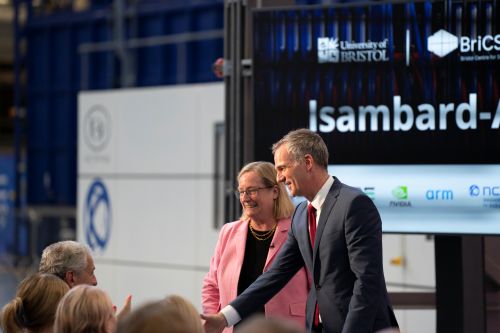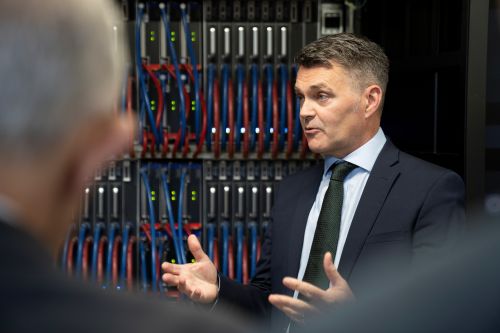
Peter Kyle, Secretary of State for Science, Innovation, and Technology, switches on Isambard-AI

Professor Evelyn Welch, Vice-Chancellor and President of the University of Bristol, with Peter Kyle, Secretary of State for Science, Innovation, and Technology

Professor Simon McIntosh-Smith, Director of the Bristol Centre for Supercomputing at the University of Bristol inside the Isambard-AI data centre
Faster, more accurate cancer diagnoses and new clean-energy innovations are some of the key breakthroughs now closer to reality as the UK's most powerful AI supercomputer launches in Bristol today [Thursday 17 July].
The £225m new Isambard-AI facility, developed by the University of Bristol in close partnership with HPE and NVIDIA, is able to process in one second what it would take the entire global population 80 years to achieve.
Such impressive processing speeds offer capacity never seen before in the UK, allowing researchers and industry to harness the huge potential of AI in fields such as robotics, big data, climate research and drug discovery.
The supercomputer, which is built and run by the Bristol Centre for Supercomputing (BriCS), and based at NCC on the Bristol and Bath Science Park, was officially launched by Peter Kyle, the Secretary of State for Science, Innovation, and Technology.
It is a key part of the UK Government's AI Research Resource (AIRR), intended to boost the country's capabilities in responsible and cutting-edge AI development.
Isambard-AI, alongside the Dawn supercomputer at the University of Cambridge, will see the UK's compute capacity increase to 23 AI ExaFLOPs - the equivalent of everyone in the UK spending 85,000 years doing what the full AIRR will do in one second.
That means everyone in the UK would have needed to start calculating more than 80,000 years before Stonehenge was built – without taking a break.
Named after revolutionary engineer Isambard Kingdom Brunel – a nod to the region's historic contributions to engineering and innovation – Isambard-AI was built in partnership with HPE, using next-generation supercomputing with HPE Cray EX that is optimised for AI workloads with 5,400 cutting-edge NVIDIA GH200 Grace Hopper Superchips.
Not only is it the 6th fastest supercomputer in Europe, it is also the 4th greenest in the world according to the Green500 list. Built to be incredibly energy efficient, the facility exclusively uses zero carbon electricity. It has been built in a low-carbon, modular data centre, installed by Oakland Construction, leading to a reduction in carbon emissions of around 72% compared to traditional build methods. It also utilises HPE's 100% fan-less, direct liquid cooling technology to deliver up to 90% reduction in cooling power consumption. There is also potential to recycle the waste heat output for nearby homes and businesses.
The University of Bristol was chosen to host the new national supercomputer research facility thanks to its long history of world-leading AI research and expertise in high performance computing.
Named 'AI University of the Year' in 2024, the university will also be training the AI pioneers of the future by offering a new fully-funded Government-backed master's degree in artificial intelligence through the Spärck AI scholarship.
Professor Evelyn Welch, Vice-Chancellor and President of the University of Bristol, said: "This is a pivotal moment for AI in the UK and the University of Bristol is proud to be at the heart of it. We have a long history of AI research, innovation and education and now we are home to the UK's most powerful AI supercomputer.
"Together with HPE and NVIDIA, we have delivered this remarkable national facility at pace, in just under 24 months. Due to its impressive power, working at speeds 100,000 times faster than an average laptop, we will soon see Isambard AI deliver transformational research and breakthroughs that will ultimately improve people's lives."
The team at the Bristol Centre for Supercomputing (BriCS) has used its experience, combined with the latest modular data centre techniques, to complete in under two years what usually takes four to five years, progressing the Isambard-AI project at unprecedented pace.
Professor Simon McIntosh-Smith, Director of the Bristol Centre for Supercomputing, said: "Isambard-AI places Bristol at the centre of the AI revolution, spearheading AI innovation and scientific discovery in important areas such as drug discovery and climate research.
"I'm incredibly proud of our team and how we've worked so closely with partners to develop this national facility which will establish Bristol and the UK as an international hub for AI research."
Today's launch follows the Technology Secretary launching a ten-year plan to boost the country's AI compute capacity. This will increase the UK's ability to deliver the next generation of game-changing breakthroughs while building up the strengths of Britain's wider AI sector.
Secretary of State for Science, Innovation, and Technology, Peter Kyle said: "Today we put the most powerful computer system in the country into the hands of British researchers and entrepreneurs. Isambard-AI doesn't just close the gap with our international competitors – it propels the UK to the forefront of AI discovery.
"With our AI Research Resource now fully up and running, the UK is home to the raw computational horsepower that will save lives, create jobs, and help us reach net zero ambitions faster.
"This is our Plan for Change in action, building the compute infrastructure that makes Britain a magnet for the world's brightest minds and boldest ideas. The breakthroughs delivered by the AI Research Resource will define the next decade, from AI tools that spot cancer earlier, to materials that help make clean energy cheaper than fossil fuels."
Researchers at the University of Bristol are using Isambard-AI to help analyse recordings from wearable cameras and other smart devices to help people perform tasks better at home – something which holds immense promise for assisting dementia patients in the future.
Videos contain far more information than images or text, but research in video understanding has been limited due to the hardware needs of handling the sheer volume of such data. This new capability of Isambard-AI is opening up exciting possibilities, including capturing footage directly from individuals in the early stages of dementia and training an AI model to help trigger stronger memories later on.
Other examples of research enabled by the supercomputer include using AI to analyse MRI scans - meaning cases of cancer can be identified sooner and patients can then be given personalised treatment plans; improving our understanding of over 30 key proteins involved in a number of diseases to help develop future treatments; and the monitoring and analysis of dairy cattle herds to detect changes in social behaviour which can serve as early indicators of subclinical diseases.
Neil MacDonald, Executive Vice President and General Manager, Server, HPE, said: "As one of the fastest AI supercomputers in the world, Isambard-AI is a vital tool in ensuring the UK remains globally competitive in the AI race. By identifying AI infrastructure as a critical national asset, the UK Government is putting the right strategy in place to be a world leader in AI. Supercomputers like Isambard-AI are incredibly complex machines, requiring a large amount of accelerated computing, high-performance networking and innovative direct liquid cooling, and generational advances in public service delivery, healthcare, education and innovation will not be possible without them."
John Josephakis, Global Vice President of Business Development for HPC and Supercomputing at NVIDIA, said: "Isambard-AI supercomputer is a vital national asset, providing researchers and innovators with advanced AI and high-performance computing resources.
"The system is a step toward establishing sovereign AI capabilities and will accelerate breakthroughs in areas like climate science, healthcare, and data analytics to drive scientific discovery and economic growth."
Richard Oldfield, CEO of NCC, said: "Hosting Isambard gives us the opportunity to harness world class digital and AI research, applying it across the product lifecycle to transform UK industry. We are accelerating the development of better products and processes to deliver stronger outcomes. That's how we drive economic growth."
Helen Godwin, the new Mayor of the West of England, said: "The country's fastest supercomputer is right at home at Bristol and Bath Science Park. Isambard-AI, hosted by the University of Bristol, will help power innovation and research that will further put our part of the world on the map. Its rapid analysis will speed up scientific advances, changing life in ways that we can scarcely imagine. This supercomputer has remarkably been built in less than two years, with businesses and researchers in the West and beyond now able to apply to use it to power our future."
Applications are now open for researchers and SMEs to use Isambard-AI, with more than 80 teams having already applied - demonstrating huge demand for this step-change in UK compute capability.






